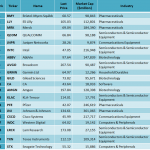As value managers, we are often asked if a company whose stock price is down substantially is a value trap. This is especially true when we are auditioning new holdings. We like to buy a company with a long history of success when it falls deeply out of favor for one reason or another. We approach this subject with a great deal of humility, since it is impossible to avoid owning some value traps over the years in order to find to your biggest winners. How do you tell the difference between an intense bargain stock and a value trap suicide mission?
First, we rely on our eight criteria for stock selection listed below:
Over the entire holding period, each holding is required to:
1. Meet an economic need
2. Boast a strong competitive advantage (wide moats or barriers to entry)
3. Have a long history of profitability and strong operating metrics
4. Generate high levels of free cash flow
5. Be available at a low price in relation to its intrinsic value
Favored, but not required criteria include:
6. Management’s history of shareholder friendliness
7. Strong balance sheet
8. Strong insider ownership (preferably with recent purchases)
Our experience is that strong balance sheets and high free cash flow allows companies with long histories of success to recover from stumbles. Every company hits a bad stretch over the decades. A few examples of these historical stumbles will be helpful.
In the early 1980s, Coca-Cola (KO) diversified into the movie business by buying Columbia Pictures. They thought that a movie with popcorn and a Coca-Cola was a wonderful vertical integration. It was a dismal failure. Coca-Cola bottomed at six-times earnings and was paying a 5% dividend in 1982. Peter Lynch coined the term “diworsification” around that time. Warren Buffett bought shares of Coca-Cola stock in 1988 at eighteen-times earnings. Coca-Cola divested Columbia Pictures in 1989 and the stock appreciated ten-fold in the following years.
When the U.S. was attacked on September 11th of 2001, most investors were sure that nobody would want to travel. Disney’s (DIS) stock plummeted to a low around $15 per share, which they once again reached in March of 2003 at the bottom of the 2000-2003 bear market. Whoever put the time in has been well rewarded.














Leave A Comment